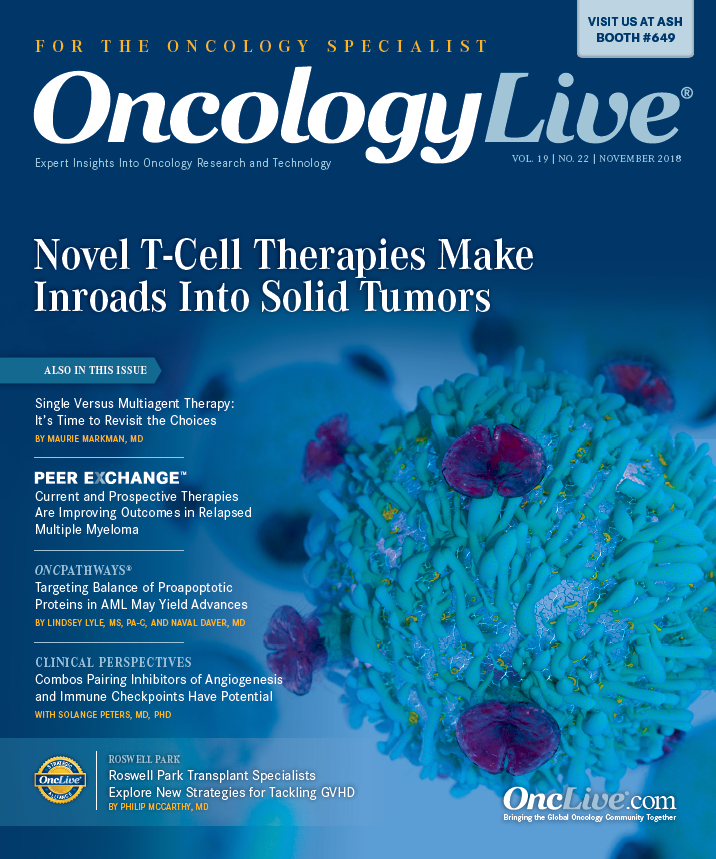Publication
Article
Oncology Live®
Combos Pairing Inhibitors of Angiogenesis and Immune Checkpoints Have Potential
Author(s):
Therapies that inhibit angiogenesis are attracting fresh interest in combination regimens with immune checkpoint immunotherapy in tumor types such as hepatocellular carcinoma, urothelial carcinoma, and endothelial cancer.
Solange Peters, MD, PhD

Solange Peters, MD, PhD
Therapies that inhibit angiogenesis are attracting fresh interest in combination regimens with immune checkpoint immunotherapy in tumor types such as hepatocellular carcinoma (HCC), urothelial carcinoma, and endothelial cancer.
The rationale for pursing this approach is grounded in tumor biology. Tumor masses contain regulatory lymphocytes, dendritic cells, alternatively activated macrophages, and myeloid-derived suppressor cells, as well as dysregulated and functionally impaired immune cells, Solange Peters, MD, PhD, said at the European Society for Medical Oncology (ESMO) 2018 Molecular Analysis for Personalised Therapy Congress. She said the hy pothesi s behind combining angiogenesis inhibitors and immunotherapy is that ablation or “reprogramming” the microenvironment might boost the efficacy of anticancer therapy.
“All these mechanisms might contribute. Angiogenic response and immune response are very importantly correlated,” said Peters, ESMO president-elect and head of the Medical Oncology Service and chair of thoracic oncology in the Oncology Department at the Centre Hospitalier Universitaire Vaudois in Lausanne, Switzerland. “Angiogenic factors impair lymphocyte trafficking across endothelia. VEGF has profound effects on cancer immunity.”
VEGF promotes the formation of blood vessels and tumor vasculature (FIGURE). Additionally, VEGF induces proliferation of regulatory T cells, favors accumulation of myeloid-derived suppressor cells, and inhibits dendritic cell maturation, antigen presentation, and T-cell responses such as upregulation of PD-L1. Results from studies have shown that VEGF blockade induces antitumor immune response while also increasing T-cell homing and improving vaccine therapy.
As a result, investigators have explored the combination of antiangiogenic agents, such as lenvatinib (Lenvima), ramucirumab (Cyramza), and bevacizumab (Avastin), with immunotherapy agents, including pembrolizumab (Keytruda) and atezolizumab (Tecentriq), for years, hoping to improve outcomes.
Figure. Process of Angiogenesis and Inhibition in Cancer
Atezolizumab Plus Bevacizumab in Hepatocellular Carcinoma
Peters reviewed data from 3 studies presented first at the 2018 American Society of Clinical Oncology Annual Meeting showing the progress investigators have made with these agents.PD-1/PD-L1 checkpoint inhibitors have been associated with promising activity as monotherapy in patients with HCC, and VEGF inhibition with bevacizumab has shown “modest activity” in this population. Based on positive results from phase III trials analyzing this combination in the first line for patients with renal cell carcinoma and non—small cell lung cancer, investigators hypothesized that bevacizumab might boost the efficacy of atezolizumab by “reversing VEGF-mediated immunosuppression and promoting T-cell infiltration into the tumor.”1
In a phase Ib clinical trial cohort (NCT02715531), treatment-naïve patients with advanced, unresectable, or metastatic HCC were assigned to 1200 mg of atezolizumab and 15 mg/kg of bevacizumab every 3 weeks until progression, unacceptable toxicity, or loss of clinical benefit. Patients who received any amount of the study combination (n = 43) were included in the safety evaluation, and those followed for a minimum of 16 weeks (n = 23) were included in the efficacy assessment.
At a median follow-up of 10.3 months (range, 3.5-17.3), the objective response rate (ORR) was 61% according to investigator assessment and 65% by independent review facility. Both assessments determined that 14 patients had partial responses. The independent review also determined that 1 patient (4%) had a complete response.
As assessed by investigators, the median duration of treatment has not yet been reached (range, 1.7+ to 14.0+ months). Similarly, median progression-free survival (PFS) and overall survival (OS) have not been reached. The 6-month PFS rate was 65%, and the 6-month OS rate was 86%, according to both investigator and independent assessments. As of January 2018, 10 of 14 responses were ongoing for ≥6 months. Three responses were ongoing for ≥1 year, according to investigator assessment.
There were 15 (35%) grade 3/4 adverse events (AEs) recorded, 12 (28%) of which were treatment related. The most common (≥5%) grade 3/4 treatment-related AE was hypertension (16%). There were 11 (26%) serious AEs, 3 (7%) of which were treatment related.
Two patients died in the study. Neither death was related to the study treatment. Results from this small study led to an FDA breakthrough designation for the combination of atezolizumab and bevacizumab for use as a frontline regimen for patients with advanced or metastatic HCC in July 2018.
Ramucirumab Plus Pembrolizumab in Urothelial Carcinoma
Investigators have also expanded this cohort to continue assessing this combination in the phase III IMbrave150 trial (NCT03434379). The estimated study completion date is June 2022.Agents targeting PD-1 or PD-L1 have shown durable activity in patients with urothelial carcinoma, but other patients have had only progressive disease as best response. To improve outcomes, investigators explored the combination of ramucirumab, an anti-VEGFR2 agent, and pembrolizumab in the 2-stage phase IA/B JVDF basket trial (NCT02443324).2
Patients with histologically confirmed urothelial carcinoma who had progressed on 1 to 3 lines of prior chemotherapy were eligible (n = 24) for the multicohort study. The median patient age was 63 years (range, 45-87), and patients were mostly male (58%).
Eleven patients (46%) had received adjuvant or neoadjuvant therapy, and 15 (63%) had received ≥2 lines of therapy for advanced disease. All patients had received prior gemcitabine (Gemzar), and 19 (79%) had received prior cisplatin. The bladder or urethra was the primary tumor site for 19 patients, while the renal pelvis or ureter was the primary site for 5 (21%).
Combined positive score ≥1% was the threshold for PD-L1 positivity. Half of the patients were PD-L1 positive, and 11 were negative.
Patients received 10 mg/kg of ramucirumab and 200 mg of pembrolizumab every 3 weeks. Treatment continued for up to 35 cycles or until confirmed progression or withdrawal.
In second- to fourth-line treatment, ORR in PD-L1—negative patients was 0% compared with 25% (95% CI, 5.5%-57.2%) in PD-L1–positive patients. The median time to response was 2.8 months (95% CI, 1.3-5.5), and the median duration of response was 8.3 months (95% CI, 4.6-16.8).
In PD-L1—negative patients, the median PFS was 1.3 months (95% CI, 0.4-1.9) and the median OS was 4.8 months (95% CI, 0.6-13.9). The median PFS was 2.5 months (95% CI, 1.2-7.4), and the median OS was 6.4 months (95% CI, 2.5–not reached [NR]) among PD-L1– positive patients.
Colitis (8%) was the only grade 3/4 AE to appear in ≥5% of patients.
Lenvatinib Plus Pembrolizumab in Endometrial Cancer
Peters said this combination is being explored in phase II trials and might “open a field of new strategies.”Peters said that “striking” results from the multiarm, multicenter, open-label phase IB/ II basket Study 111/KEYNOTE-146 trial (NCT02501096) led the FDA to grant a breakthrough therapy designation for the combination of lenvatinib and pembrolizumab in August 2018. The designation is indicated for the treatment of patients with advanced and/or metastatic non—microsatellite instability-high/ proficient mismatch repair endometrial carcinoma who have progressed after ≥1 prior systemic therapy.3 Currently, there are no approved therapies for these patients.
As of the December 2017 data cutoff, interim results in the endometrial cancer cohort showed an ORR at week 24 per independent radiology review of 45.3% (95% CI, 31.6%-59.6%). The overall ORR was 47.2% (95% CI, 33.3%-61.4%), including 3 complete responses and 25 partial responses.
“This is a disease [that] is not easily treated, and these patients are highly pretreated with at least 2 lines of chemotherapy,” she said.
Patients (n = 53) were treated with 20 mg of once-daily lenvatinib plus 200 mg of pembrolizumab every 3 weeks. The primary endpoint was ORR at 24 weeks and included only evaluable patients who had 24 weeks of follow-up or who had discontinued treatment or died before 24 weeks.
The median PFS was 7.4 months (95% CI, 5.0-NR). Overall, 79.3% of patients had a duration of response ≥12 months.
The most common grade 3 treatment-related AEs (TRAEs) included hypertension (34%) and diarrhea (8%). Investigators observed no grade 4 TRAEs, and 30% of patients had serious TRAEs.
Five patients died during the study. Only 1 death, from an intracranial hemorrhage, was considered to be related to the study treatment.
“Integration of PD-1, PD-L1, and possibly also CTLA-4 inhibition has shown some synergistic activity with antiangiogenesis across diseases,” Peters concluded. “We still have to define the best opportunities, the best partners, and the best diseases, but I think that’s the way to move.”
References
- Stein S, Pishvaian MJ, Lee MS, et al. Safety and clinical activity of 1L atezolizumab + bevacizumab in a phase Ib study in hepatocellular carcinoma (HCC). J Clin Oncol. 2018;36(suppl; abstr 4074). meetinglibrary.asco.org/record/160179/abstract.
- Herbst RS, Chau I, Petrylak DP, et al. Activity of ramucirumab (R) with pembrolizumab (P) by PD-L1 expression in advanced solid tumors: phase 1a/b study in later lines of therapy. J Clin Oncol. 2018;36(suppl; abstr 3059). meetinglibrary.asco.org/ record/159229/abstract.
- Makker V, Rasco DW, Vogelzang NJ, et al. Lenvatinib + pembrolizumab in patients with advanced endometrial cancer: updated results. J Clin Oncol. 2018;36(suppl; abstr 5596). meetinglibrary.asco.org/record/161528/abstract.










